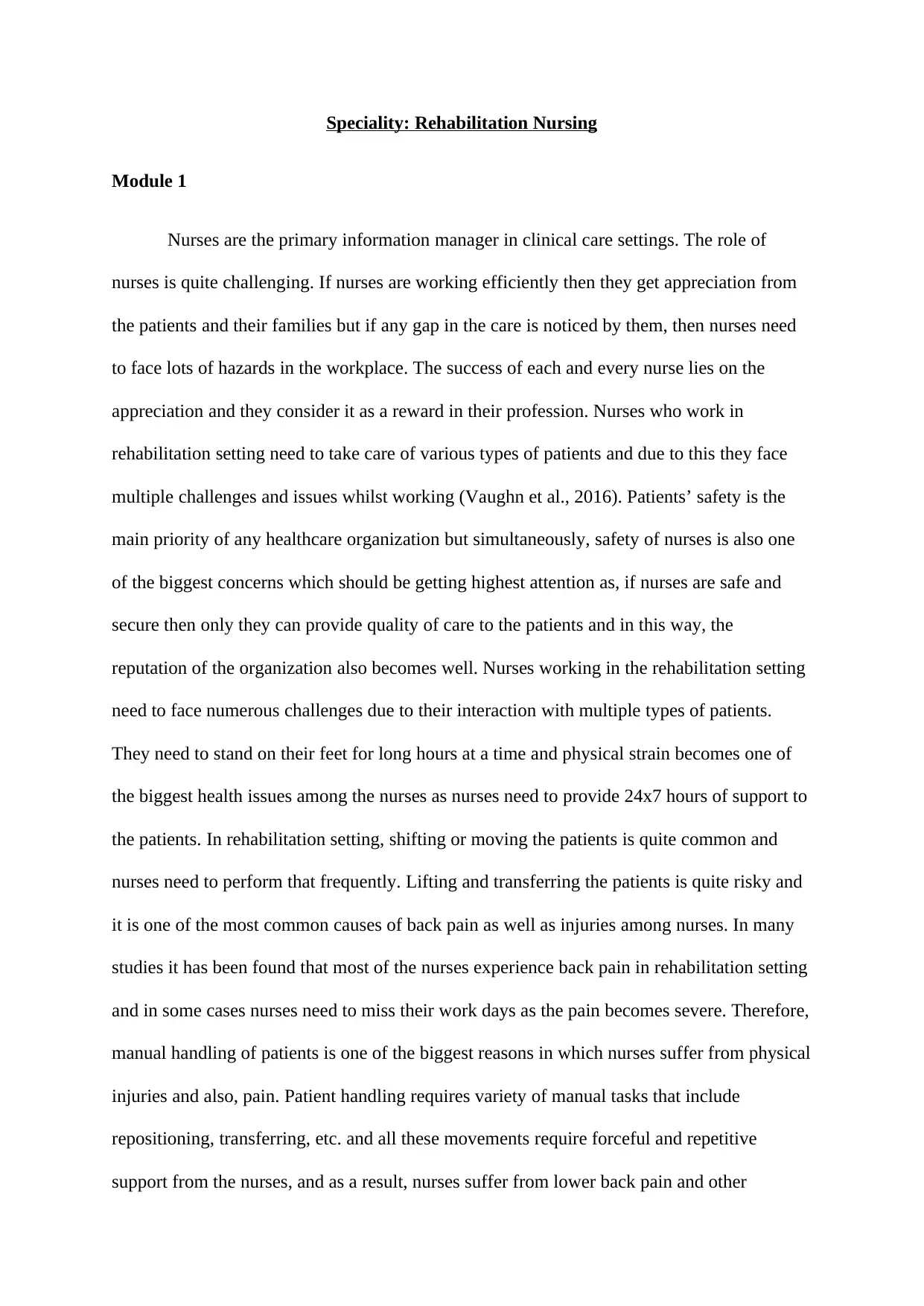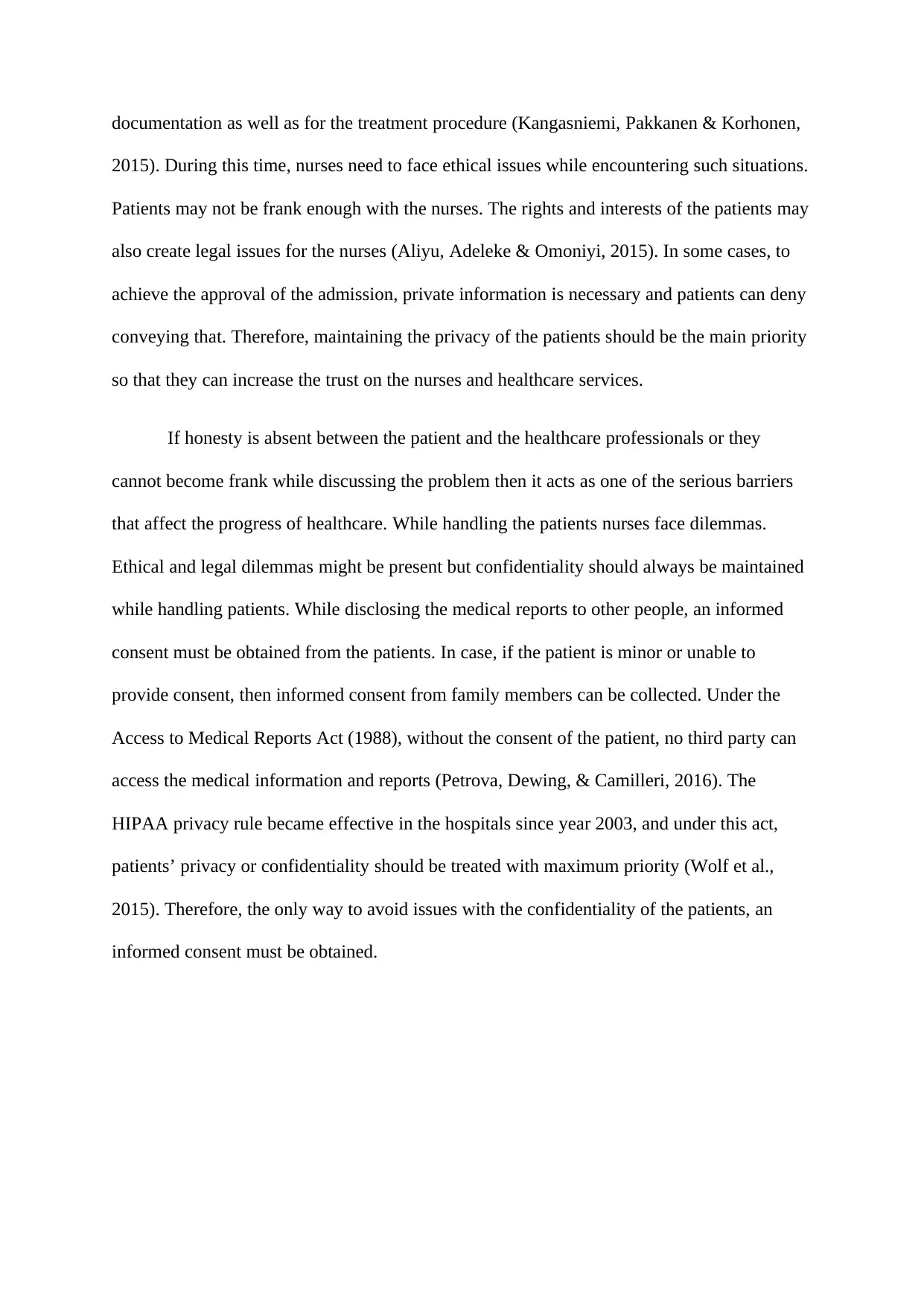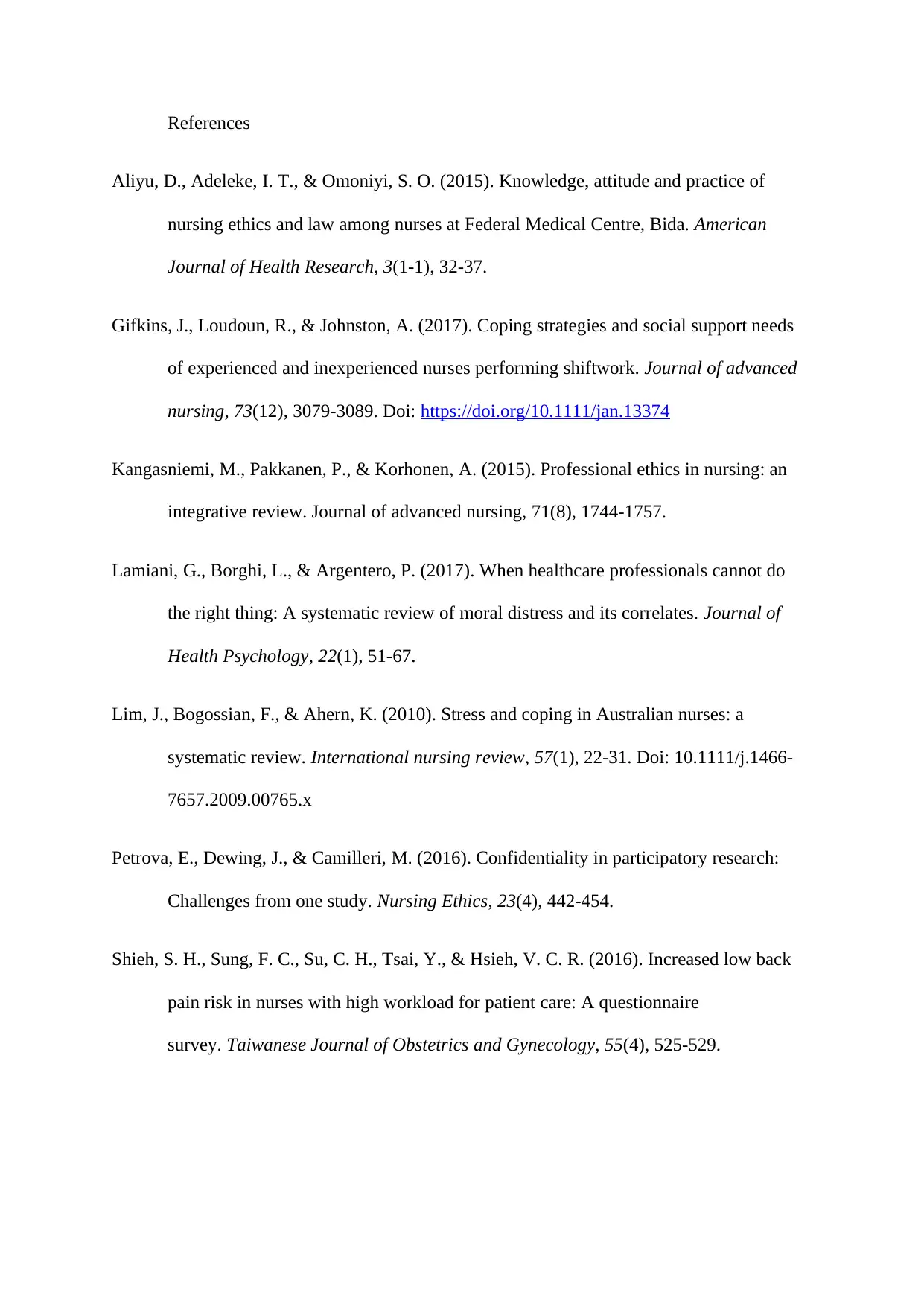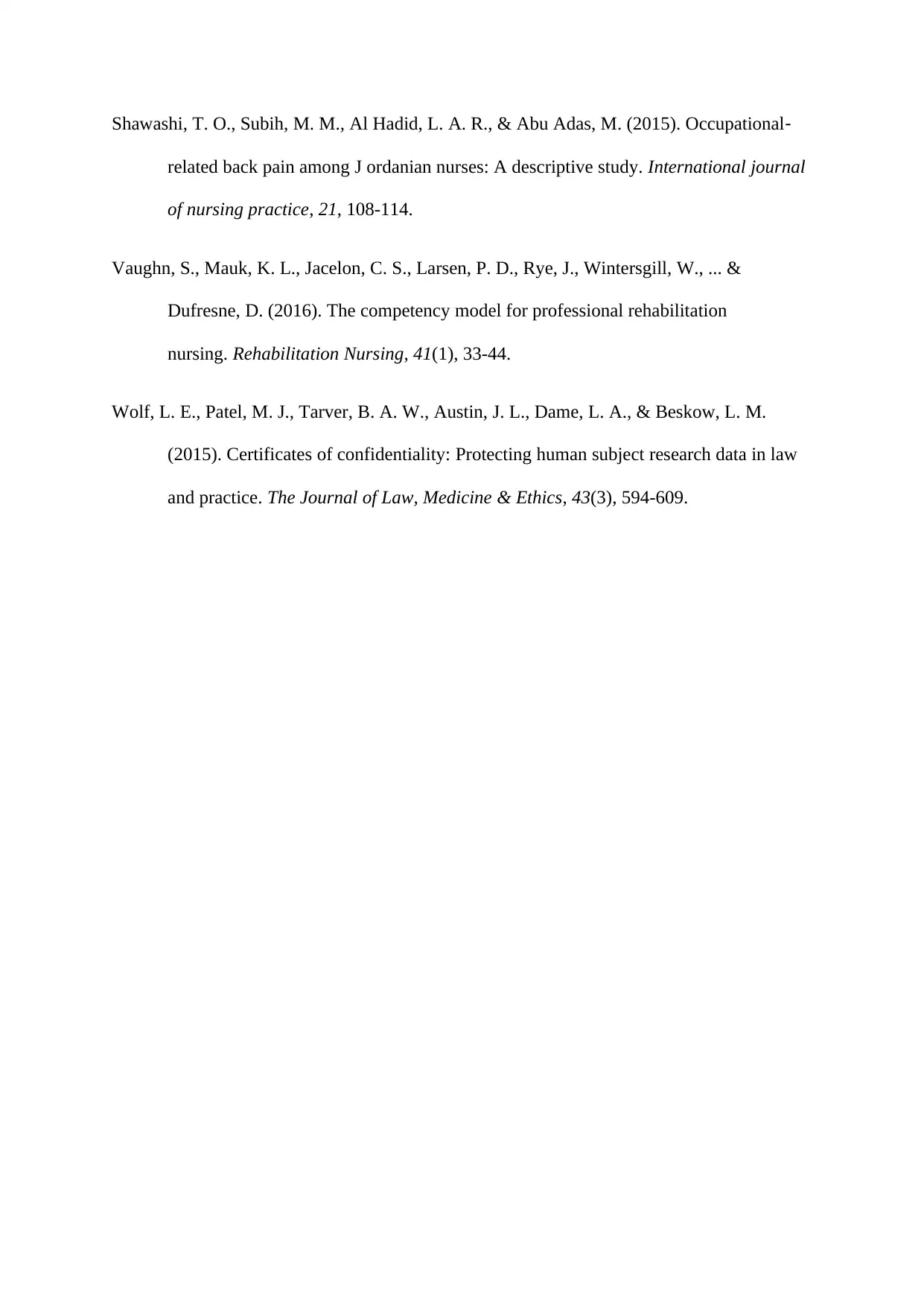Challenges and Dilemmas Faced by Rehabilitation Nurses: A Report
VerifiedAdded on 2023/06/04
|6
|1950
|481
Report
AI Summary
This report examines the multifaceted challenges encountered by nurses in rehabilitation settings. It begins by highlighting the physical strain and potential injuries, such as back pain, resulting from patient handling and long working hours. The report then delves into ethical dilemmas, particularly those related to patient confidentiality. It emphasizes the importance of maintaining patient privacy, obtaining informed consent, and adhering to HIPAA regulations. The report discusses the balance between providing care and protecting patient rights, including the complexities of sharing medical information. It stresses the need for nurses to be cautious and informed in their practice to ensure both patient safety and their own well-being, referencing relevant studies and legal frameworks to support its arguments. The report concludes by underscoring the importance of ethical considerations in rehabilitation nursing practice.

Speciality: Rehabilitation Nursing
Module 1
Nurses are the primary information manager in clinical care settings. The role of
nurses is quite challenging. If nurses are working efficiently then they get appreciation from
the patients and their families but if any gap in the care is noticed by them, then nurses need
to face lots of hazards in the workplace. The success of each and every nurse lies on the
appreciation and they consider it as a reward in their profession. Nurses who work in
rehabilitation setting need to take care of various types of patients and due to this they face
multiple challenges and issues whilst working (Vaughn et al., 2016). Patients’ safety is the
main priority of any healthcare organization but simultaneously, safety of nurses is also one
of the biggest concerns which should be getting highest attention as, if nurses are safe and
secure then only they can provide quality of care to the patients and in this way, the
reputation of the organization also becomes well. Nurses working in the rehabilitation setting
need to face numerous challenges due to their interaction with multiple types of patients.
They need to stand on their feet for long hours at a time and physical strain becomes one of
the biggest health issues among the nurses as nurses need to provide 24x7 hours of support to
the patients. In rehabilitation setting, shifting or moving the patients is quite common and
nurses need to perform that frequently. Lifting and transferring the patients is quite risky and
it is one of the most common causes of back pain as well as injuries among nurses. In many
studies it has been found that most of the nurses experience back pain in rehabilitation setting
and in some cases nurses need to miss their work days as the pain becomes severe. Therefore,
manual handling of patients is one of the biggest reasons in which nurses suffer from physical
injuries and also, pain. Patient handling requires variety of manual tasks that include
repositioning, transferring, etc. and all these movements require forceful and repetitive
support from the nurses, and as a result, nurses suffer from lower back pain and other
Module 1
Nurses are the primary information manager in clinical care settings. The role of
nurses is quite challenging. If nurses are working efficiently then they get appreciation from
the patients and their families but if any gap in the care is noticed by them, then nurses need
to face lots of hazards in the workplace. The success of each and every nurse lies on the
appreciation and they consider it as a reward in their profession. Nurses who work in
rehabilitation setting need to take care of various types of patients and due to this they face
multiple challenges and issues whilst working (Vaughn et al., 2016). Patients’ safety is the
main priority of any healthcare organization but simultaneously, safety of nurses is also one
of the biggest concerns which should be getting highest attention as, if nurses are safe and
secure then only they can provide quality of care to the patients and in this way, the
reputation of the organization also becomes well. Nurses working in the rehabilitation setting
need to face numerous challenges due to their interaction with multiple types of patients.
They need to stand on their feet for long hours at a time and physical strain becomes one of
the biggest health issues among the nurses as nurses need to provide 24x7 hours of support to
the patients. In rehabilitation setting, shifting or moving the patients is quite common and
nurses need to perform that frequently. Lifting and transferring the patients is quite risky and
it is one of the most common causes of back pain as well as injuries among nurses. In many
studies it has been found that most of the nurses experience back pain in rehabilitation setting
and in some cases nurses need to miss their work days as the pain becomes severe. Therefore,
manual handling of patients is one of the biggest reasons in which nurses suffer from physical
injuries and also, pain. Patient handling requires variety of manual tasks that include
repositioning, transferring, etc. and all these movements require forceful and repetitive
support from the nurses, and as a result, nurses suffer from lower back pain and other
Paraphrase This Document
Need a fresh take? Get an instant paraphrase of this document with our AI Paraphraser

injuries. The problem of reduced number of nurses in many healthcare organizations is due to
this issue. In case, if any emergency situation occurs, nurses need to stay with the patient,
even if their working hours is over and they need to assist patients in all their activities that
requires lifting and moving (Shawashi, Subih, Al Hadid & Abu Adas, 2015). In rehabilitation
setting, patients are fully dependent on the assistance of the nurses such as bathing or any
other kind of performing procedures etc. and this causes several common back problems such
as lower back strain, acute disc injury in which the pain starts at the lower back and then
extends down on both the legs. Even, in a study, it has also been found that the prevalence of
lower back pain among 45 years old American nursing staffs was 47% and the worst
sufferers are the nurses working under rehabilitation setting (Shieh, Sung, Su, Tsai & Hsieh,
2016).
Various risks are there in the nursing practice. One of the main risks associated with
the nursing profession which can affect their safety, has been illustrated clearly in the
discussion. It also provides me the knowledge that nursing profession is also highly
challenging and while providing safety to the patients’ health, nurses also might face safety
concern regarding their health. In this regard, nurses need to be cautious and careful in the
rehabilitation setting whist working. Theory of proper “body mechanics” can be helpful in
minimizing the damage while moving patients. However, there is no particular safe way to
lift patients that can be helpful in preventing pain but, the discussion will help to be careful in
the workplace.
Module 2
Dilemma is basically an issue, where a problem offers two or more possibilities and
neither of which is acceptable. It is associated with the life of almost every people.
Workplace dilemma is also very common and in the profession of healthcare, nurses need to
this issue. In case, if any emergency situation occurs, nurses need to stay with the patient,
even if their working hours is over and they need to assist patients in all their activities that
requires lifting and moving (Shawashi, Subih, Al Hadid & Abu Adas, 2015). In rehabilitation
setting, patients are fully dependent on the assistance of the nurses such as bathing or any
other kind of performing procedures etc. and this causes several common back problems such
as lower back strain, acute disc injury in which the pain starts at the lower back and then
extends down on both the legs. Even, in a study, it has also been found that the prevalence of
lower back pain among 45 years old American nursing staffs was 47% and the worst
sufferers are the nurses working under rehabilitation setting (Shieh, Sung, Su, Tsai & Hsieh,
2016).
Various risks are there in the nursing practice. One of the main risks associated with
the nursing profession which can affect their safety, has been illustrated clearly in the
discussion. It also provides me the knowledge that nursing profession is also highly
challenging and while providing safety to the patients’ health, nurses also might face safety
concern regarding their health. In this regard, nurses need to be cautious and careful in the
rehabilitation setting whist working. Theory of proper “body mechanics” can be helpful in
minimizing the damage while moving patients. However, there is no particular safe way to
lift patients that can be helpful in preventing pain but, the discussion will help to be careful in
the workplace.
Module 2
Dilemma is basically an issue, where a problem offers two or more possibilities and
neither of which is acceptable. It is associated with the life of almost every people.
Workplace dilemma is also very common and in the profession of healthcare, nurses need to

face dilemmas frequently which make their profession more challenging and difficult. In
most of the cases, the dilemma in the rehabilitation setting is associated with the term
confidentiality. Nurses are the worst sufferers as they need to have a direct interaction with
the patients as well as their family members while providing care. Confidentiality in the
rehabilitation setting must be treated with highest priority as different types of patients come
with different types of private issues. In the context of the treatment team, sharing medical
reports with third party payers may be required but patients may not want to disclose highly
personal information with others. While handling patients in rehabilitation setting, the
primary assurance they want to receive is confidentiality. If they are not ensured with a 100%
secure and safe service regarding the privacy of the patient, they do not want to disclose
anything which is required to proceed in the treatment (Lamiani, Borghi & Argentero, 2017).
Before providing services, they need to ensure the patients about their confidentiality with the
support of privacy laws of patients.
Maintaining confidentiality is a key factor to build trustworthy relationship with the
patient which helps in the progress of treatment as well. If the privacy or confidentiality is not
maintained properly, then in future, patients might not be cooperative with the healthcare
professionals and the reputation of the organization is also hampered in this way. Before
making any professional judgement and decision making, the patient must be ensured with
the protection of privacy (Vaughn et al., 2016). Again, maintaining the privacy of the medical
reports of the patients is also highly essential. It is the right of every patient that they can
keep their medical reports private and without their consent it can never be accessed or
revealed to any third party. In the nursing profession, nurses are always responsible to
maintain the privacy of the patient related information.
In rehabilitation clinical setting, patients generally come to stay and during the
preadmission review, nurses need to ask various private questions that are required for the
most of the cases, the dilemma in the rehabilitation setting is associated with the term
confidentiality. Nurses are the worst sufferers as they need to have a direct interaction with
the patients as well as their family members while providing care. Confidentiality in the
rehabilitation setting must be treated with highest priority as different types of patients come
with different types of private issues. In the context of the treatment team, sharing medical
reports with third party payers may be required but patients may not want to disclose highly
personal information with others. While handling patients in rehabilitation setting, the
primary assurance they want to receive is confidentiality. If they are not ensured with a 100%
secure and safe service regarding the privacy of the patient, they do not want to disclose
anything which is required to proceed in the treatment (Lamiani, Borghi & Argentero, 2017).
Before providing services, they need to ensure the patients about their confidentiality with the
support of privacy laws of patients.
Maintaining confidentiality is a key factor to build trustworthy relationship with the
patient which helps in the progress of treatment as well. If the privacy or confidentiality is not
maintained properly, then in future, patients might not be cooperative with the healthcare
professionals and the reputation of the organization is also hampered in this way. Before
making any professional judgement and decision making, the patient must be ensured with
the protection of privacy (Vaughn et al., 2016). Again, maintaining the privacy of the medical
reports of the patients is also highly essential. It is the right of every patient that they can
keep their medical reports private and without their consent it can never be accessed or
revealed to any third party. In the nursing profession, nurses are always responsible to
maintain the privacy of the patient related information.
In rehabilitation clinical setting, patients generally come to stay and during the
preadmission review, nurses need to ask various private questions that are required for the
⊘ This is a preview!⊘
Do you want full access?
Subscribe today to unlock all pages.

Trusted by 1+ million students worldwide

documentation as well as for the treatment procedure (Kangasniemi, Pakkanen & Korhonen,
2015). During this time, nurses need to face ethical issues while encountering such situations.
Patients may not be frank enough with the nurses. The rights and interests of the patients may
also create legal issues for the nurses (Aliyu, Adeleke & Omoniyi, 2015). In some cases, to
achieve the approval of the admission, private information is necessary and patients can deny
conveying that. Therefore, maintaining the privacy of the patients should be the main priority
so that they can increase the trust on the nurses and healthcare services.
If honesty is absent between the patient and the healthcare professionals or they
cannot become frank while discussing the problem then it acts as one of the serious barriers
that affect the progress of healthcare. While handling the patients nurses face dilemmas.
Ethical and legal dilemmas might be present but confidentiality should always be maintained
while handling patients. While disclosing the medical reports to other people, an informed
consent must be obtained from the patients. In case, if the patient is minor or unable to
provide consent, then informed consent from family members can be collected. Under the
Access to Medical Reports Act (1988), without the consent of the patient, no third party can
access the medical information and reports (Petrova, Dewing, & Camilleri, 2016). The
HIPAA privacy rule became effective in the hospitals since year 2003, and under this act,
patients’ privacy or confidentiality should be treated with maximum priority (Wolf et al.,
2015). Therefore, the only way to avoid issues with the confidentiality of the patients, an
informed consent must be obtained.
2015). During this time, nurses need to face ethical issues while encountering such situations.
Patients may not be frank enough with the nurses. The rights and interests of the patients may
also create legal issues for the nurses (Aliyu, Adeleke & Omoniyi, 2015). In some cases, to
achieve the approval of the admission, private information is necessary and patients can deny
conveying that. Therefore, maintaining the privacy of the patients should be the main priority
so that they can increase the trust on the nurses and healthcare services.
If honesty is absent between the patient and the healthcare professionals or they
cannot become frank while discussing the problem then it acts as one of the serious barriers
that affect the progress of healthcare. While handling the patients nurses face dilemmas.
Ethical and legal dilemmas might be present but confidentiality should always be maintained
while handling patients. While disclosing the medical reports to other people, an informed
consent must be obtained from the patients. In case, if the patient is minor or unable to
provide consent, then informed consent from family members can be collected. Under the
Access to Medical Reports Act (1988), without the consent of the patient, no third party can
access the medical information and reports (Petrova, Dewing, & Camilleri, 2016). The
HIPAA privacy rule became effective in the hospitals since year 2003, and under this act,
patients’ privacy or confidentiality should be treated with maximum priority (Wolf et al.,
2015). Therefore, the only way to avoid issues with the confidentiality of the patients, an
informed consent must be obtained.
Paraphrase This Document
Need a fresh take? Get an instant paraphrase of this document with our AI Paraphraser

References
Aliyu, D., Adeleke, I. T., & Omoniyi, S. O. (2015). Knowledge, attitude and practice of
nursing ethics and law among nurses at Federal Medical Centre, Bida. American
Journal of Health Research, 3(1-1), 32-37.
Gifkins, J., Loudoun, R., & Johnston, A. (2017). Coping strategies and social support needs
of experienced and inexperienced nurses performing shiftwork. Journal of advanced
nursing, 73(12), 3079-3089. Doi: https://doi.org/10.1111/jan.13374
Kangasniemi, M., Pakkanen, P., & Korhonen, A. (2015). Professional ethics in nursing: an
integrative review. Journal of advanced nursing, 71(8), 1744-1757.
Lamiani, G., Borghi, L., & Argentero, P. (2017). When healthcare professionals cannot do
the right thing: A systematic review of moral distress and its correlates. Journal of
Health Psychology, 22(1), 51-67.
Lim, J., Bogossian, F., & Ahern, K. (2010). Stress and coping in Australian nurses: a
systematic review. International nursing review, 57(1), 22-31. Doi: 10.1111/j.1466-
7657.2009.00765.x
Petrova, E., Dewing, J., & Camilleri, M. (2016). Confidentiality in participatory research:
Challenges from one study. Nursing Ethics, 23(4), 442-454.
Shieh, S. H., Sung, F. C., Su, C. H., Tsai, Y., & Hsieh, V. C. R. (2016). Increased low back
pain risk in nurses with high workload for patient care: A questionnaire
survey. Taiwanese Journal of Obstetrics and Gynecology, 55(4), 525-529.
Aliyu, D., Adeleke, I. T., & Omoniyi, S. O. (2015). Knowledge, attitude and practice of
nursing ethics and law among nurses at Federal Medical Centre, Bida. American
Journal of Health Research, 3(1-1), 32-37.
Gifkins, J., Loudoun, R., & Johnston, A. (2017). Coping strategies and social support needs
of experienced and inexperienced nurses performing shiftwork. Journal of advanced
nursing, 73(12), 3079-3089. Doi: https://doi.org/10.1111/jan.13374
Kangasniemi, M., Pakkanen, P., & Korhonen, A. (2015). Professional ethics in nursing: an
integrative review. Journal of advanced nursing, 71(8), 1744-1757.
Lamiani, G., Borghi, L., & Argentero, P. (2017). When healthcare professionals cannot do
the right thing: A systematic review of moral distress and its correlates. Journal of
Health Psychology, 22(1), 51-67.
Lim, J., Bogossian, F., & Ahern, K. (2010). Stress and coping in Australian nurses: a
systematic review. International nursing review, 57(1), 22-31. Doi: 10.1111/j.1466-
7657.2009.00765.x
Petrova, E., Dewing, J., & Camilleri, M. (2016). Confidentiality in participatory research:
Challenges from one study. Nursing Ethics, 23(4), 442-454.
Shieh, S. H., Sung, F. C., Su, C. H., Tsai, Y., & Hsieh, V. C. R. (2016). Increased low back
pain risk in nurses with high workload for patient care: A questionnaire
survey. Taiwanese Journal of Obstetrics and Gynecology, 55(4), 525-529.

Shawashi, T. O., Subih, M. M., Al Hadid, L. A. R., & Abu Adas, M. (2015). Occupational‐
related back pain among J ordanian nurses: A descriptive study. International journal
of nursing practice, 21, 108-114.
Vaughn, S., Mauk, K. L., Jacelon, C. S., Larsen, P. D., Rye, J., Wintersgill, W., ... &
Dufresne, D. (2016). The competency model for professional rehabilitation
nursing. Rehabilitation Nursing, 41(1), 33-44.
Wolf, L. E., Patel, M. J., Tarver, B. A. W., Austin, J. L., Dame, L. A., & Beskow, L. M.
(2015). Certificates of confidentiality: Protecting human subject research data in law
and practice. The Journal of Law, Medicine & Ethics, 43(3), 594-609.
related back pain among J ordanian nurses: A descriptive study. International journal
of nursing practice, 21, 108-114.
Vaughn, S., Mauk, K. L., Jacelon, C. S., Larsen, P. D., Rye, J., Wintersgill, W., ... &
Dufresne, D. (2016). The competency model for professional rehabilitation
nursing. Rehabilitation Nursing, 41(1), 33-44.
Wolf, L. E., Patel, M. J., Tarver, B. A. W., Austin, J. L., Dame, L. A., & Beskow, L. M.
(2015). Certificates of confidentiality: Protecting human subject research data in law
and practice. The Journal of Law, Medicine & Ethics, 43(3), 594-609.
⊘ This is a preview!⊘
Do you want full access?
Subscribe today to unlock all pages.

Trusted by 1+ million students worldwide
1 out of 6
Related Documents
Your All-in-One AI-Powered Toolkit for Academic Success.
+13062052269
info@desklib.com
Available 24*7 on WhatsApp / Email
![[object Object]](/_next/static/media/star-bottom.7253800d.svg)
Unlock your academic potential
Copyright © 2020–2025 A2Z Services. All Rights Reserved. Developed and managed by ZUCOL.





